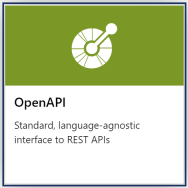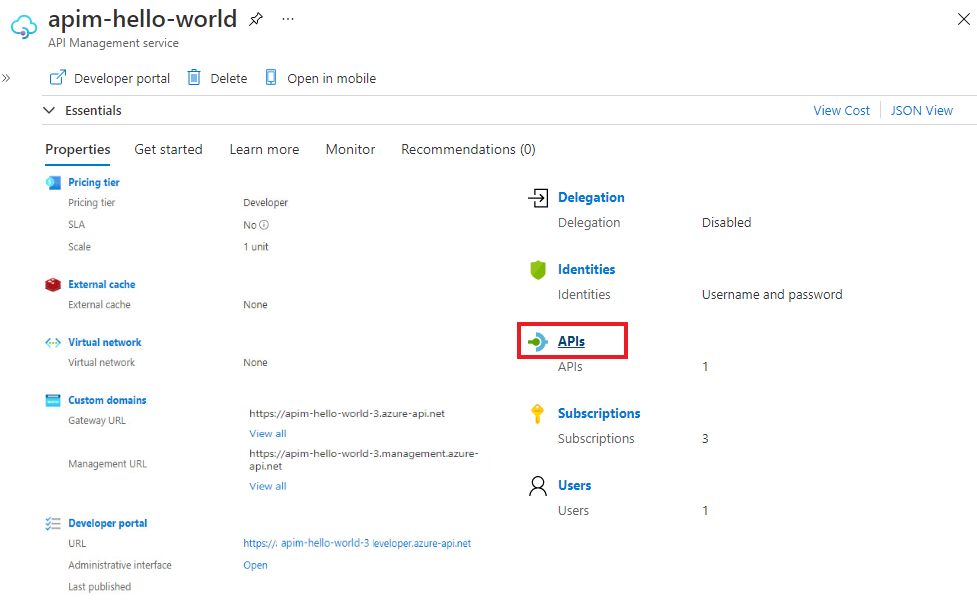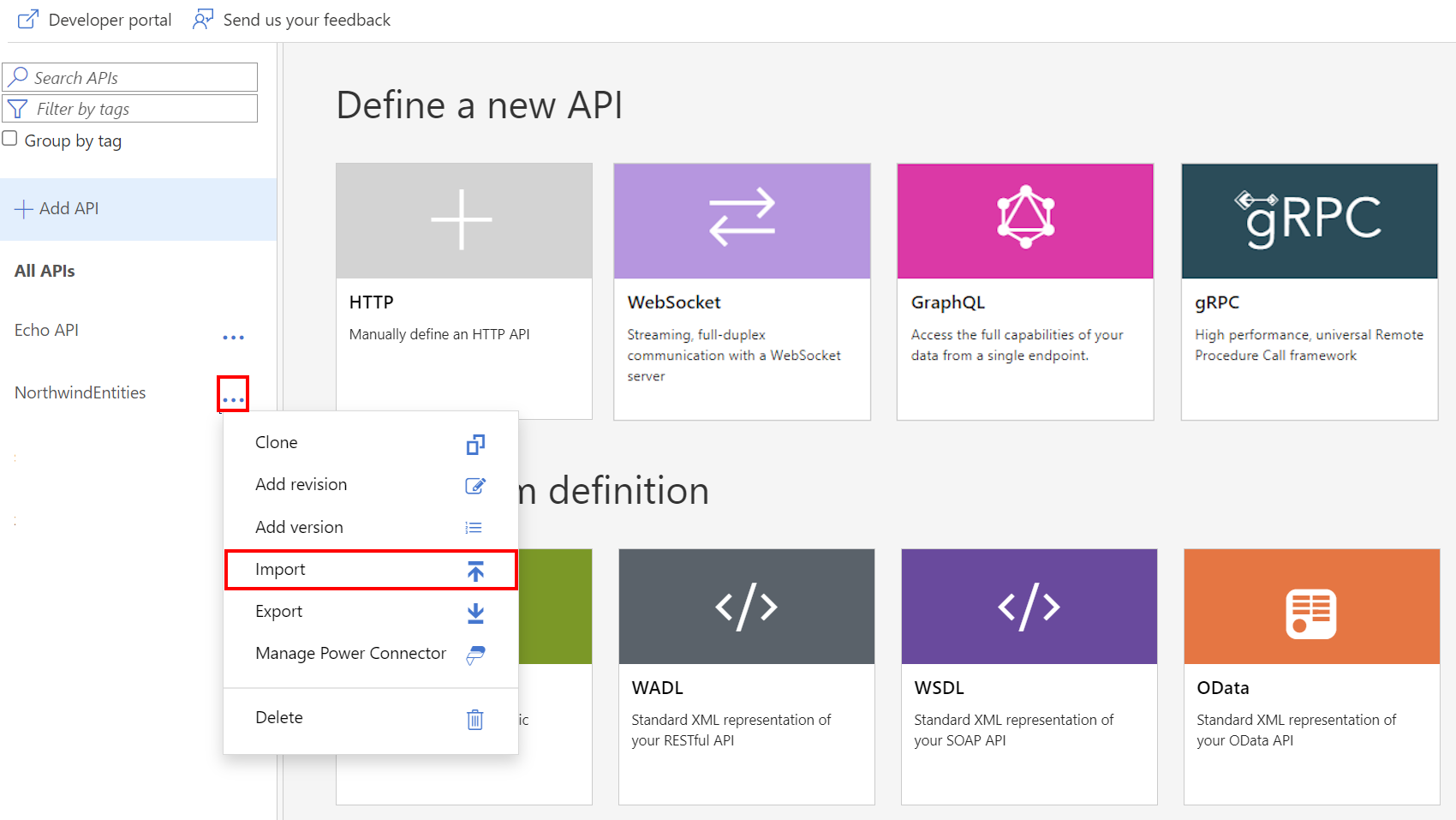หมายเหตุ
การเข้าถึงหน้านี้ต้องได้รับการอนุญาต คุณสามารถลอง ลงชื่อเข้าใช้หรือเปลี่ยนไดเรกทอรีได้
การเข้าถึงหน้านี้ต้องได้รับการอนุญาต คุณสามารถลองเปลี่ยนไดเรกทอรีได้
APPLIES TO: All API Management tiers
This article shows how to import an "OpenAPI specification" backend API to Azure API Management using various tools. The article also shows how to test the API in API Management.
In this article, you learn how to:
- Import an OpenAPI specification using the Azure portal, Azure CLI, or Azure PowerShell
- Test the API in the Azure portal
Note
API import limitations are documented in API import restrictions and known issues.
Prerequisites
An API Management instance. If you don't already have one, complete the following quickstart: Create an Azure API Management instance.
Azure CLI
Use the Bash environment in Azure Cloud Shell. For more information, see Get started with Azure Cloud Shell.
If you prefer to run CLI reference commands locally, install the Azure CLI. If you're running on Windows or macOS, consider running Azure CLI in a Docker container. For more information, see How to run the Azure CLI in a Docker container.
If you're using a local installation, sign in to the Azure CLI by using the az login command. To finish the authentication process, follow the steps displayed in your terminal. For other sign-in options, see Authenticate to Azure using Azure CLI.
When you're prompted, install the Azure CLI extension on first use. For more information about extensions, see Use and manage extensions with the Azure CLI.
Run az version to find the version and dependent libraries that are installed. To upgrade to the latest version, run az upgrade.
Azure PowerShell
- If you choose to use Azure PowerShell locally:
- Install the latest version of the Az PowerShell module.
- Connect to your Azure account using the Connect-AzAccount cmdlet.
- If you choose to use Azure Cloud Shell:
- See Overview of Azure Cloud Shell for more information.
- If you choose to use Azure PowerShell locally:
Import a backend API
For this example, you import the OpenAPI specification for the open source Petstore API, but you can substitute an OpenAPI specification of your choice.
In the Azure portal, navigate to your API Management instance.
In the left menu, select APIs > + Add API.
Under Create from definition, select OpenAPI.

Enter API settings. You can set the values during creation or configure them later by going to the Settings tab. The settings are explained in the Import and publish your first API tutorial.
Select Create.
View and edit OpenAPI specification
In the portal, use the OpenAPI specification editor to view, validate, or edit the specification for the API that you imported.
To use the OpenAPI specification editor:
- In the Azure portal, navigate to your API Management instance.
- In the left menu, under APIs, select APIs > <your API> > All operations.
- On the Design tab, in Frontend, select OpenAPI Specification editor (pencil icon). You can open the specification in JSON or YAML format.
- Review or edit the specification as needed. Save your changes.
Validate against an OpenAPI specification schema
You can configure API Management validation policies to validate requests and responses (or elements of them) against the schema in an OpenAPI specification. For example, use the validate-content policy to validate the size or content of a request or response body.
Test the new API in the portal
Operations can be called directly from the portal, which provides a convenient way for administrators to view and test the operations of an API.
Select the API you created in the previous step.
Select the Test tab.
Select an operation. The page displays fields for query parameters and fields for the headers.
Note
In the test console, API Management automatically populates an Ocp-Apim-Subscription-Key header, and configures the subscription key of the built-in all-access subscription. This key enables access to every API in the API Management instance. Optionally display the Ocp-Apim-Subscription-Key header by selecting the "eye" icon next to the HTTP Request.
Depending on the operation, enter query parameter values, header values, or a request body. Select Send.
When the test is successful, the backend responds with a successful HTTP response code and some data.
Tip
By default, the test console sends a request to API Management's CORS proxy, which forwards the request to the API Management instance, which then forwards it to the backend. This proxy uses public IP address 13.91.254.72 and can only reach public endpoints. If you want to send a request directly from the browser to the API Management service, select Bypass CORS proxy. Use this option when you want to use the test console and your API Management gateway is network-isolated or doesn't allow traffic from the CORS proxy.
To debug an API, see Tutorial: Debug your APIs using request tracing.
Append other APIs
You can compose an API out of APIs that are exposed by different services, including:
- An OpenAPI specification
- A SOAP API
- A GraphQL API
- A Web App that's hosted in Azure App Service
- Azure Functions
- Azure Logic Apps
- Azure Service Fabric
Note
When you import an API, the operations are appended to your current API.
To append an API to an existing API:
Go to your Azure API Management instance in the Azure portal:
Select APIs on the Overview page or select APIs > APIs in the menu on the left.
Select the ellipsis (...) next to the API that you want to append another API to.
Select Import from the drop-down menu:
Select a service from which to import an API.
Related content
- API import limitations
- Import an OpenAPI specification
- Import a SOAP API
- Import a SOAP API and convert it to REST
- Import an App Service API
- Import a container app API
- Import a WebSocket API
- Import a GraphQL API
- Import a GraphQL schema and set up field resolvers
- Import a function app API
- Import a logic app API
- Import a Service Fabric service
- Import an Azure AI Foundry API
- Import an Azure OpenAI API
- Import an LLM API
- Import an OData API
- Export a REST API as an MCP server
- Expose an existing MCP server
- Import an A2A agent API
- Import SAP OData metadata
- Import a gRPC API
- Edit an API



